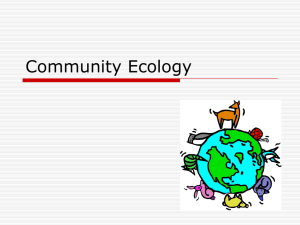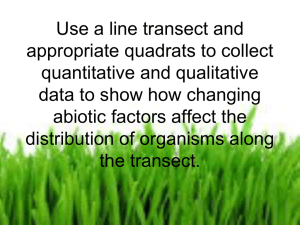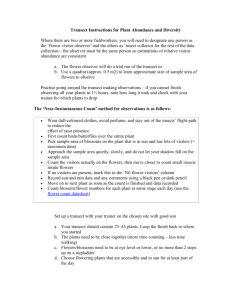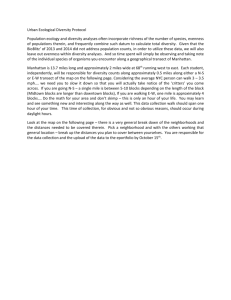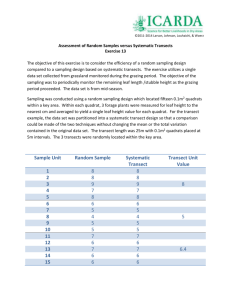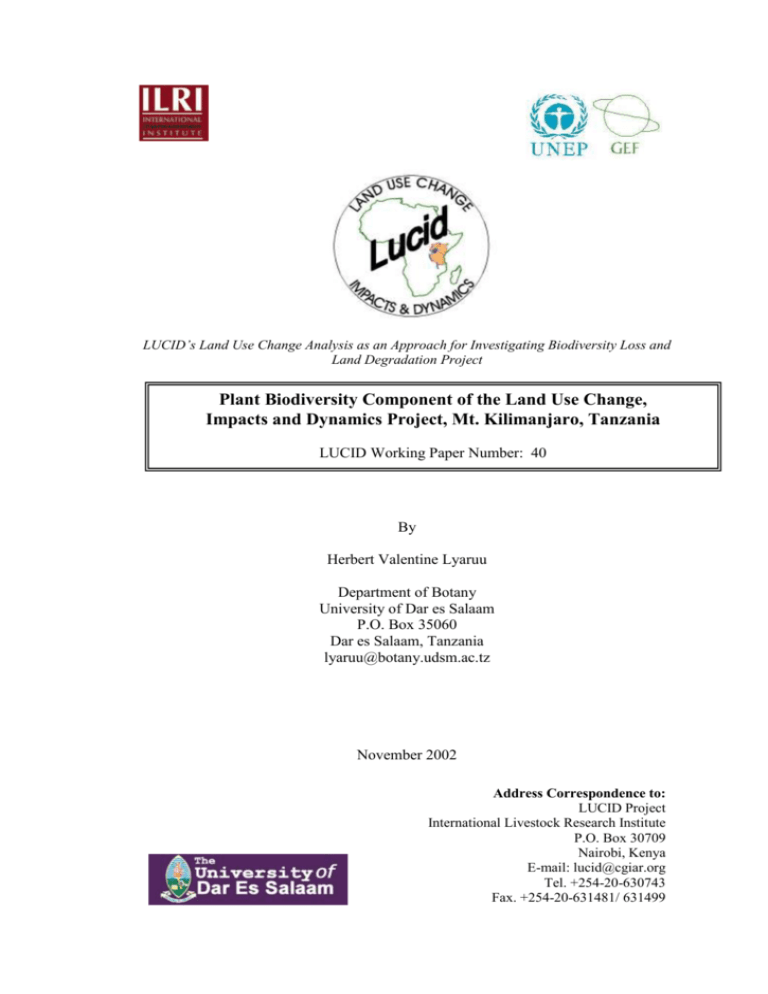
LUCID’s Land Use Change Analysis as an Approach for Investigating Biodiversity Loss and
Land Degradation Project
Plant Biodiversity Component of the Land Use Change,
Impacts and Dynamics Project, Mt. Kilimanjaro, Tanzania
LUCID Working Paper Number: 40
By
Herbert Valentine Lyaruu
Department of Botany
University of Dar es Salaam
P.O. Box 35060
Dar es Salaam, Tanzania
lyaruu@botany.udsm.ac.tz
November 2002
Address Correspondence to:
LUCID Project
International Livestock Research Institute
P.O. Box 30709
Nairobi, Kenya
E-mail: lucid@cgiar.org
Tel. +254-20-630743
Fax. +254-20-631481/ 631499
Plant Biodiversity Component of the Land Use Change,
Impacts and Dynamics Project, Mt. Kilimanjaro, Tanzania
The Land Use Change, Impacts and Dynamics
Working Paper Number: 40
By
Herbert Valentine Lyaruu
Department of Botany
University of Dar es Salaam
P.O. Box 35060
Dar es Salaam, Tanzania
lyaruu@botany.udsm.ac.tz
November 2002
Address Correspondence to:
LUCID Project
International Livestock Research Institute
P.O. Box 30709
Nairobi, Kenya
E-mail: lucid@cgiar.org
Tel. +254-20-630743
Fax. +254-20-631481/ 631499
Copyright © 2002 by the:
University of Dar es Salaam,
International Livestock Research Institute, and
United Nations Environment Programme/Division of Global Environment Facility Coordination.
All rights reserved.
Reproduction of LUCID Working Papers for non-commercial purposes is encouraged. Working
papers may be quoted or reproduced free of charge provided the source is acknowledged and
cited.
Cite working paper as follows: Author. Year. Title. Land Use Change Impacts and Dynamics
(LUCID) Project Working Paper #. Nairobi, Kenya: International Livestock Research Institute.
Working papers are available on www.lucideastafrica.org or by emailing lucid@cgiar.org.
LUCID Working Paper 40
ii
TABLE OF CONTENTS
A. INTRODUCTION ............................................................................................................... 1
A.1. Specific objectives of the study ........................................................................................ 1
A.2. Hypotheses ....................................................................................................................... 1
B. METHODOLOGY ............................................................................................................. 1
B.1. Limitation of the Results................................................................................................... 3
C. RESULTS AND DISCUSSION ......................................................................................... 3
C.1. Multivariate Analysis Results .......................................................................................... 3
C.2. Diversity and Species Richness Patterns along Transects ............................................... 3
C.3. Status of Economically Useful Plants along the Transects .............................................. 8
C.4. Patterns of Change of Biodiversity .................................................................................. 8
C.5. Impact on Floral Diversity ............................................................................................... 9
C.6. Species of High Conservation Value ............................................................................... 9
D. DISCUSSION AND RECOMMENDATIONS ................................................................. 9
References .............................................................................................................................. 13
TABLES
1. Economically Useful Plants Cited by Informants along Mbokomu Transect .................... 11
2. Economically Useful Plants Cited by Informants along Machame Transect ..................... 12
FIGURES
1.
2.
3.
4.
5.
6.
7.
Effect of Land Use on Biodiversity (Spp Richness, Mbukomu Transect) .......................... 4
Effect of Land Use on Biodiversity (Spp Richness, Machame Transect) ........................... 4
Effect of Land Use on Biodiversity (Shannon’s Diversity, Mbukomu Transect) ............... 5
Effect of Land Use on Biodiversity (Shannon’s Diversity, Machame Transect) ................ 5
Effect of Land Use on Biodiversity (Mono vs. Polyculture, Spp Richness, Mbukomu) ..... 6
Effect of Land Use on Biodiversity (Mono vs. Polyculture, Spp Richness, Machame) ..... 6
Scatter Diagram Depicted from Detrended Correspondence Analysis of
Plots Under Different Land Use Systems in Machame and Mbokomu transects ................ 7
8. Scatter Diagram of the Plots Under Different Land Use Systems in
Machame and Mbokomu transects as Depicted from Canonical Correspondence
Analysis (CCA) Results ...................................................................................................... 8
LUCID Working Paper 40
iii
A. INTRODUCTION
Tropical drylands are generally nutrient-poor ecosystems with a potentially low productivity due
to insufficient and erratic rainfall, and are highly susceptible to vegetation and soil degradation.
Whereas soil degradation results from wind and water erosion, waterlogging, salinization,
alkalization, acidification, pollution and compaction, vegetation degradation manifests itself as
reduction of vegetation cover or changes in species composition and diversity. It is estimated that
2 billion hectares of soil have become degraded, specifically due to human activities, since 1945,
out of these 1.5 billion hectares being in developing countries (see Kangalawe, 2001 and
references cited therein). Soil erosion and low fertility in agricultural lands are perceived as the
greatest threat to soil productivity in dryland Africa (Kangalawe, 2001).
A survey was carried out along two transects located on the southern slopes of Mount
Kilimanjaro, with an overall objective of finding out how different land use practices affect plant
biodiversity and consequently land degradation. The two transects run from the forest belt to the
lowlands where people are engaged in irrigation agriculture. Of the two transects, one transect
along Machame route started at an altitude of 1840 metres above the sea level down to Kikafu
Chini which lies at an altitude of 770 metres. The Mbokomu transect started from the forest belt at
around 1830 metres down to Mabogini at an elevation of 686 metres. Comparatively the
Machame transect was much longer and it crossed several land use types than the Mbokomu
transect. Topographically, Mbokomu transect traversed very steep and rugged hillslopes, such that
it was in some cases impossible to lay quadrats where the sub-transects fell.
A.1. Specific objectives of the study
The study had three main objectives:
1. To compare biodiversity of areas which have been subjected to different land use
practices.
2. To establish the relationship between soil conditions and the extant vegetation in the areas
understudy.
3. To establish plant bio-indicator species that are associated with different land use
practices and soil conditions, in attempt to link them with soil/land degradation.
A.2. Hypotheses
1. Specific land use practices and soil management such as weeding or monoculture
cropping greatly influences species composition of any given area.
2. Species diversity is likely to increase with increase in soil fertility.
3. The rate of deterioration of land/soil quality can be established based on the diversity and
number of indicator species.
B. METHODOLOGY
Reconnaissance survey was conducted in the two transects of Machame and Mbokomu prior to
the sampling exercise in order to explore the existing variations in land use patterns and to assist
the team in judging whether sampling the two transects could address the objectives outlined
above.
Along each transect, 12 sub-transects which run perpendicular to the main transect were
established such that for each major agro-ecological zone there were 4 sub-transects. The major
agro-ecological zones encountered included the coffee/banana zone (both high and mid-altitude
LUCID Working Paper 40
1
zones); the cultivated land and the lowlands where the main activity was pastoralism and
irrigation agriculture. The length of a sub-transect was variable depending on how close different
land use categories were found, but generally sub-transects covered 500 metres on either side of
the main transect.
During the sampling exercise, a minimum of two quadrats representing each land use category
were sampled, and in some cases up to 3 different land use categories could be found in one subtransect. In case where there was only one site representing a specific land use category, the site
was also sampled in order to capture maximum variability of biodiversity in each sub-transect.
In accordance with the sampling protocol outlined in the LUCID cookbook (Maitima and Olson
2001), different sizes of quadrats were used depending on the type of the vegetation, the criteria
being the vegetation height. For example woodlots were sampled in 20 x 20 square metre plots,
whereas coffee/banana plots were sampled in 10 x 10 square metre quadrats. Monocultural crops
such as maize at different stages of development, as well as herbs and grasses were sampled using
quadrats ranging from 1 x 1 square metres to 4 x 4 square metre plots.
In the sampling procedure, individual plants were identified to species level, counted and
recorded, and the contribution of each species to percentage cover was estimated and recorded.
Specimens that were difficult to identify in the field were collected, pressed and transported to
Dar es Salaam for confirmation of their identity. Such unidentified specimens were properly
determined at the University of Dar es Salaam Herbarium by matching with preserved herbarium
specimens or by keying using floras and manuals.
A questionnaire was administered to a number of people along each transect in order to obtain
information on the economically important plant species found in the area and their current status,
to indicate whether they were declining over time or were increasing. Information was also sought
about species which have become extinct in the study area, their possible cause of the extinction
and habitats where such species were found.
Composite soil samples were collected from the vegetation plots and were later analysed in the
laboratory using the standard procedures for cation exchange capacity, pH, organic carbon,
exchangeable bases and total nitrogen. The soil analysis results were combined with the
vegetation data in multivariate analysis in order to reveal the indicator species of different soil
conditions.
Calculation of species diversity was done using the Shannon & Wiener Diversity Index (as in
Magurran, 1988) from the relationship H’ = -pilnpI, where pi is the relative proportion of the ith
species in the sample. Evenness (E) or equitability which is a measure of how individuals are
distributed for each species was calculated from the relationship E = H’/lnS, where S is the
species richness. Similarity between samples of the same land use category was calculated based
on Sørensen’s (1948) Similarity index from the relationship
SI = 2C/A + B,
where C are species common to samples A and B, A is total number of species found in sample A
and B represents the total number of species found in sample B.
Multivariate analysis of the data was performed using the programme PC-ORD Version 4.20
(McCune & Mefford 2000). The data were analysed using Canonical Correspondence Analysis
(CCA), Detrended Correspondence Analysis (DCA) and Two Way Indicator Species Analysis
(TWINSPAN). The data matrices used were the species/plots data x soil/altitude/plots data which
served as the environmental variables.
LUCID Working Paper 40
2
The nomenclature used in this study follows that of Turrill & Milne-Redhead (1952-) in Flora of
Tropical East Africa and that of Excel & Wild (1960-) in Flora Zambesiaca.
B.1. Limitation of the Results
Although sampling technique which employs square quadrats is becoming obsolete
nowadays (see account by Stohlgren et al., 1995), the team adopted square quadrats in
order to obtain comparable data with the Kenyan counterparts, who did their field work
much earlier.
The use of different size quadrats suggested in the LUCID cookbook was a serious
problem to data interpretation. Effective comparison of the data could not be done for
different land use categories because each vegetation type was sampled using quadrats of
different sizes. For example it was possible to compare graze land, fallow land, maize
fields, paddy fields and fodder since these entities were sampled in 2 x 2 m2 quadrats.
C. RESULTS AND DISCUSSION
A total of 40 quadrats were sampled along Mbokomu transect with eleven land use categories and
with coffee/banana as the major land use type. The information on species diversity (H’),
evenness (E) and species richness (S) of the plots sampled along Mbokomu transect was later on
used to plot graphs on effects of land use change on biodiversity. For Machame transect where
there were more land use categories, a total of 81 quadrats were sampled with an indication that
maize and coffee/banana were the major land use categories of this area. The results are presented
as Figures 1-6.
C.1. Multivariate Analysis Results
The relationship between soil factors and species diversity for both Machame and Mbokomu
transects is rather complex in that all four axes of the ordination space account for the observed
relationship. However axes I and II explain more than 60% of the observed variance, and so only
these two axes will be considered in the discussion. The most influential variables which account
for the observed relationship are pH, altitude and organic carbon. The first axis of the ordination
space explains the observed variance by ca. 36.2%, and it depicts decrease in altitude from the
forest belt through the coffee/banana zone to the lowlands where irrigation agriculture is practiced
(Figures 7 and 8).
C.2. Diversity and Species Richness Patterns along Transects
Generally species diversity and richness were observed to increase with decrease in altitude and
also increase in the soil pH. This implies that the undisturbed lowlands which were used as
pastureland to include the scrubland and the shrubland were much more diverse having a number
of grass species and shrubs which were not encountered anywhere else in the transects. The
notable shrubs included Commiphora africana, Boscia angustifolia, Croton pseudopluchellus,
Grewia burtii, Solanum incanum, Hyptis suavelons and Ocimum suave. A number of palatable
annual grasses in this vegetation type include Eragrostis superba, Pennisetum polystachion,
Heteropogon contortus and Eragrostis aethiopica.
LUCID Working Paper 40
3
16
14
Species Richness (S)
12
10
8
6
4
y = -1.0804x + 14.773
R2 = 0.9365
2
0
Fallow
Fallow
Grazeland
Grazeland
Grazeland
Grazeland
Maize
Maize
Paddy
Fodder
Fodder
Paddy
Figure 1: Effect of Land Use Change on Biodiversity (Mbokomu Transect)
14
12
8
6
y = -0.5846x + 12.527
R2 = 0.8124
4
2
tu
re
cu
l
cu
l
Ho
rti
Ho
rti
tu
re
ze
M
ai
tu
re
cu
l
Ho
rti
ze
tu
re
cu
l
Ho
rti
M
ai
ze
M
ai
ze
M
ai
Fo
dd
er
nd
Gr
az
el
a
lo
w
Fa
l
nd
Gr
az
el
a
lo
w
Fa
l
lo
w
0
Fa
l
Species Richness (S)
10
Figure 2: Effect of Land Use Change on Biodiversity (Machame Transect)
LUCID Working Paper 40
4
3
Shannon's Diversity (H)
2.5
2
1.5
1
y = -0.1829x + 2.6016
R2 = 0.9839
0.5
0
Fallow
Grazeland
Fallow
Grazeland
Grazeland
Grazeland
Grazeland
Paddy
Maize
Paddy
Cassava
Figure 3: The Effect of Land Use Change on Biodiversity (Mbokomu Transect).
2.5
1.5
y = -0.0349x + 2.1222
R2 = 0.9671
1
0.5
de
r
M
ai
H
or
z
tic e
ul
tu
re
M
ai
H
or
ze
tic
ul
tu
re
M
ai
ze
M
ai
ze
M
ai
ze
M
G aiz
e
ra
ze
la
nd
Fa
G llow
ra
ze
G l an
d
ra
z
H elan
or
tic d
u
G lture
ra
ze
la
nd
M
ai
z
Fo e
dd
e
Fo r
d
H
or de
r
tic
u
Se ltur
e
ttl
em
en
Fa t
Se llo
ttl w
em
en
t
M
G aiz
e
ra
ze
la
nd
M
ai
ze
M
G aiz
e
ra
ze
la
nd
Fo
dd
er
Fa
llo
w
Fa
llo
w
0
Fo
d
Shannon's Diversity (H)
2
Figure 4: The Effect of Land Use Change on Biodiversity (Machame Transect).
LUCID Working Paper 40
5
e/
Ba
na
n
C
C
LUCID Working Paper 40
of
fe
e
Ba
na
na
Ba
na
na
of
fe
e
Species Richness(S)
na
na
Ba
na
na
Ba
na
na
Ba
fe
e
of
C
a
na
n
Ba
a
na
n
Ba
e/
of
fe
C
a
na
n
Ba
e/
of
fe
C
a
na
n
a
a
na
n
Ba
e/
of
fe
C
e/
of
fe
C
Ba
na
n
a
a
na
n
Ba
e/
of
fe
C
e/
of
fe
C
Ba
na
n
a
a
na
n
Ba
e/
of
fe
C
e/
of
fe
C
Ba
na
n
a
na
n
Ba
e/
of
fe
C
e/
of
fe
C
Ba
e/
of
fe
C
Species Richness (S)
8
C
of
fe
e
4
C
Ba
na
na
Ba
na
na
C
a
a
e/
Ba
na
n
of
fe
of
fe
a
e/
Ba
na
n
C
a
e/
Ba
na
n
of
fe
C
a
e/
Ba
na
n
of
fe
of
fe
a
C
a
e/
Ba
na
n
C
of
fe
e/
Ba
na
n
of
fe
a
C
a
e/
Ba
na
n
of
fe
e/
Ba
na
n
of
fe
C
C
16
14
12
10
y = -0.2321x + 13.057
R2 = 0.3735
6
4
2
0
Figure 5: The Effect of Land Use Change on Biodiversity (Poly- vs Monoculture Mbokomu Transect).
20
18
16
14
12
10
8
6
y = -0.6882x + 14.475
R2 = 0.6297
2
0
Figure 6: The Effect of Land Use Change on Biodiversity (Poly-vs Monoculture Machame Transect).
6
Axis 2
3
4
32
24
37
39
7
35
1
9
43
36
41
13
5
10
6
14
40
16 22
46 29
42
12
26
19
44
38
51
8
30
18
15
48
45
31
52
27
20
Axis 1
54
25
17
2
11
28
47
21 50
33
53
23
55
56
49
34
Figure 7. Scatter Diagram Depicted from Detrended Correspondence Analysis of Plots Under
Different Land Use Systems in Machame and Mbokomu transects.
There was not any definitive pattern of change in biodiversity and similarity of sites exhibiting the
same land use along a gradient from high altitude to the irrigable lowlands at lower altitudes. This
may lead to a suggestion that diversity observed along transects is dictated by factors such as soil
conditions, amount of precipitation and land management system rather than altitude.
LUCID Working Paper 40
7
Plot30
Axis 2
Plot26
Plot24
Plot4
Plot1
Plot9
Plot10
Plot3
Plot5
Plot2
Plot35
Plot22
Plot7
Ca
A ltitude
Plot33
Plot36
Plot17
Plot29
Plot23
Plot32
Plot56
Plot27
Axis 1
Plot40
Plot39
Plot8
Plot12 Plot6
Plot37
Plot41 Plot38
pH
Plot14
Plot55
Plot46
Plot11
Plot20
Plot16
Plot19
Plot31
Plot44 Plot45
Plot47
Plot42
Plot25
Plot13
Plot50
Plot34
Plot51
Plot15
Plot49
Plot18
Plot43
Plot21 K
Plot53
Plot48
Plot28
Figure 8. Scatter Diagram of the Plots Under Different Land Use Systems in Machame and
Mbokomu transects as Depicted from Canonical Correspondence Analysis (CCA) Results.
C.3. Status of Economically Useful Plants along the Transects
Information from questionnaires revealed that a number of plants are very useful and are used in
various ways. A number of people cited among the uses as medicinal plants, timber trees, fodder,
shade trees for coffee and others have great cultural significance among the Chagga. Among the
ailments treated using herbal medicine were stomach upsets, persistent coughs, ethnoveternary
use for both livestock and chicken, treating wounds, fever, fungicidals and many others. A total of
15 species were cited from Mbokomu transect as being economically useful, whereas in Machame
about 24 species were enumerated. A complete list of plants, their uses, their level of abundance
and their common species names are provided as Tables 1 and 2 below.
C.4. Patterns of Change of Biodiversity
There was a tendency of decreasing species richness and diversity from uncultivated land to
cultivated land along the transect (see Figures 1 – 6). At sub-transect level, the variation was not
noticeable. This discrepancy can be explained by the management practices in cultivation of
weeding which eliminates unwanted species and partly can be explained the use of agricultural
inputs such as fertilizers and pesticides which modify the soil conditions, thereby favouring
selectively specific species.
At agro-ecological zone level, an increase in diversity was observed with decrease in altitude. The
lowlands of which the common land use practice was irrigation agriculture and pastoralism had
high diversity of grass species and shrubs which were absent in the highlands.
LUCID Working Paper 40
8
C.5. Impact on Floral Diversity
Each land use category was characterized by certain group of plants which served to indicate the
prevailing soil conditions of the area. As an example the maize fallows seemed to be of very poor
soil fertility and showed a decreased species diversity. The fallows were dominated by
Trichodesma zeylanicum, Argemone mexicana, Physalis peruviana, Euphorbia hirta and Solanum
incanum.
In areas which were used for pastoral activities a number of annual grass species were
encountered such as Eragrostis superba, Pennisetum polystachion, Heteropogon contortus and
Eragrostis aethiopica were common. Presence of the annual grasses and a number of unpalatable
shrubs is a reflection of high grazing pressure exhibited in the area.
In the coffee/banana zone, the species diversity was also very low and this is accounted by land
management practices. A number of species were common as indicators of cultivation and of
humid soils such as Oxalis corniculata, Bidens pilosa, Senecio abyssinica, Setaria homonyma,
Digitaria scalarum and Launea cornuta. Together with such weeds, were some cultivated crops
such as Ananas comosus, Helianthus annuus and Carica papaya.
C.6. Species of High Conservation Value
In the context of this work, I consider species of conservation concern as any of the species which
fall in any one of the categories below:
endemic species,
species overexploited for timber,
species with narrow range of distribution,
medicinal plants of which their harvesting mode was not sustainable,
species difficult to propagate, and
keystone species. An example of keystone species are figs which have fruits all year
round and so are the cultivated fruit crops.
Among the timber trees, Olea welwitschii, Cordia africana and Albizia gummifera were species
subjected to overexploitation in the range where they occur. Although two of the cited trees are
coffee shade trees, they are declining in number due to timber production. Such species tend to
decrease in number as one moves from the high altitudes to the lowlands.
On the issue of sustainability of harvesting medicinal plants, at least for four species cited, the
harvesting mode is not sustainable because harvesting involves total de-barking of the individual
plants or by obtaining the roots. This in fact has an effect of killing the trees and could be
disastrous where only few individuals of the species are present. It was noted that Erythrina
abyssinica, Grewia burtii, Lannea stuhlmannii and Terminalia sericea were species most affected
by this unsustainable mode of harvesting. Generally, the diversity of medicinal plants was highest
in the uncultivated land than in cultivated land, specifically with scrubland having the highest
density.
Elsewhere in Tanzania, the species cited above are already on the verge of extinction and
therefore there is an urgent need to promote the conservation of their populations wherever they
occur.
D. DISCUSSION AND RECOMMENDATIONS
The interview revealed that there has been a tremendous loss of biodiversity of economically
useful plants due to habitat fragmentation in the recent years and the practice is still going on to
date. The most important explanation to this trend of loss in biodiversity can be explained by the
existing land tenure system among the Chagga, which results into fragmentation of the land. By
this it implies that the traditional system of distributing part of the family shamba (locally known
LUCID Working Paper 40
9
as Kihamba) to every boy born in the family, results into less land available for cultivation in
favour of building houses.
Another possible explanation to the observed loss of biodiversity can partly be attributed to
changes in the land use practices in Kilimanjaro. To cite an example, horticulture is now a
lucrative business when compared to traditional coffee farming system due to the high market
price of horticultural crops. People are clearing coffee farms and replacing them with tomato,
onions etc. Generally, vegetable farming requires a lot of agricultural inputs such as fertilizers and
pesticides which have detrimental effects on plant biodiversity. Also the practice of using blue
copper (copper sulphate) and thiodan in coffee farms has an effect of increasing soil acidity and
consequently favouring certain groups of plants.
The practice of using organic manure resulting from zero grazing and mulches which was very
common along Machame transect should be encouraged as a means to improve soil fertility as
well as increasing soil pH and consequently productivity and species diversity.
In view of this study, it is recommended to carry out intensive studies for all those species which
are likely to disappear in the near future. Such studies should include their ecological and
silvicultural aspects, and also to find out the distribution pattern of their populations wherever
they occur in Tanzania.
Machame transect is much more diverse in terms of land use categories, species diversity and
species richness compared to Mbokomu transect. Along Machame transect below 1000 metre
altitude, there is very arid vegetation confined to shallow skeletal soils which I have termed scrub
land. This is an important zone where people practice agro-pastoralism. The unique feature of
this land use type is a very high diversity of palatable annual grasses such as Eragrostis superba,
Pennisetum polystachion, Eragrostis aethiopica and Heteropogon contortus. Research has shown
elsewhere that intensive grazing has an effect of increasing the diversity of annual grasses in a
rangeland (see O’Connor & Pickett, 1991), increasing seed influx passively into the area (Lyaruu,
1999) as well as reducing the perennial grasses which are obligate seed producers.
Agricultural practices of tilling the land selectively favours certain groups of plants which feature
as weeds. Secondly the practice of turning the soil exposes seeds to optimum germination
conditions, thereby increasing the short-lived ephemerals.
Precipitation among other factors dictates the type of vegetation to be found in an area. The
Machame transect is presumably wetter than the eastern side of the mountain hence can support
high diversity of plants. In line with this I am convinced that the coffee/banana zone is nonexistent but can further be extended down the lowland depending on the availability of water.
Prior to the commencement of the lower Moshi irrigation scheme, there were no banana crops in
the lowland.
Acknowledgements
This study forms part of a multidisciplinary research on Land Use Change, Impacts and Dynamics
(LUCID) in East Africa funded by UNEP-GEF. The author would like to express heartfelt
appreciation for being part of the project as a contracted researcher for Geography Department of
the University of Dar es Salaam. I would like to thank my employer, the University of Dar es
Salaam for granting me permission to undertake this assignment in Mount Kilimanjaro.
LUCID Working Paper 40
10
Table 1. Economically Useful Plants Cited by Informants along Mbokomu Transect
Species Name
Rumex abyssinicus
Local Name
(Chagga)
Ilimilimi
Rauvolfia caffra
Msesewe
Todallia asiatica
Mkananga
Tabenaemontana
pachysiphon
Dracaena studneri
Irahacha
Solanum incanum
Ndulele
Vernonia adoensis
Cassia didymobotrya
Latangao
Albizia gummifera
Mfuruanje
Cordia Africana
Mringaringa
Olea welwitschii
Loliondo
Grevillea robusta
Mwerezi
Coffee shade tree,
timber
Eucalyptus saligna
Mikaratusi
Eucalyptus globulus
Mikaratusi
Cuppressus lusitanica
-
Timber, poles,
fuelwood
Timber, poles,
fuelwood
Timber, fuel wood,
poles
Isale
Use
Abundance Level
Medicinal (stomach
disorders)
Anthelmintic, catalyst
in fermentation
process
Stomachache, cancer,
fodder, boundaries
Anti-thrombin, wound
healing
Stomachache, rituals,
boundary markers
Stomachache
Very common along
water courses
Very common
Persistent coughs
Ethno-veterinary for
treating constipation
Timber, coffee shade
trees
Timber, fodder, coffee
shade tree, fuel wood
Timber, poles
LUCID Working Paper 40
Declining in
abundance
Very common
Very common
Widespread ruderal
of disturbed land
Widespread ruderal
Very common
Common
Common
Declining due to
overexploitation
Exotic species
naturalized in many
parts of Tanzania
Introduced species
from Australia
as above
Exotic species
naturalized in
Tanzania.
11
Table 2. Economically Useful Plants Cited by Informants along Machame Transect
Species Name
Grewia burtii
Euphorbia cuniata
Local Name
(Chagga)
Seseti
Use
Abundance Level
Ethno-veterinary,
fungicidal
Ethno-veterinary
(chicken)
Fever, anaemia
Declining due to clearance of
farms
Very common
Lannea stuhlmannii
Mlangari
pori
-
Terminalia sericea
Mbugwe
Agauria salicifolia
-
Azadirachta indica
Mwarobaini
Plecranthus
kilimandscharica
Rauvolfia caffra
Wombo
Cordia Africana
Mringaringa
Albizia gummifera
Mruka,
mfuruanje
Psidium guajava
Mpera
Stomache upset,
appetizer
Anthelmintic, catalyst
of fermentation
process of mbege
Coffee shade, ethnoveterinary, timber
Stomach disorder,
timber, fuel wood,
coffee shade tree
Stomachache
Persea americana
Parachichi
Toothache
Solanum incanum
Ndulele
Stomachache
Erythrina abyssinica
-
Ethno-veterinary as a
treatment of mastitis
Ricinus communis
Mbarika
Painkiller, purgative
Dracaena steudneri
Isale
Cassia didymobotrya
Sansevieria conspicua
Katani pori
Setaria homonyma
Ilale
Stomachache, cultural
significance, boundary
markers
Amoebic dysentry
Ethnoveterinary for
chicken
Stomachache
Grevillea robusta
Mwerezi
Eucalyptus saligna
Mikaratusi
Eucalyptus globulus
Mikaratusi
Msesewe
Ethno-veterinary,
persistent coughs,
dysentry
Treatment of open
wounds
Fever, pesticide
Coffee shade tree,
timber
Timber, poles,
fuelwood
Timber, poles,
fuelwood
LUCID Working Paper 40
Declining due to
unsustainable mode of
harvesting
Declining due to
unsustainable mode of
harvesting
Declining due to clearance of
farms
Planted and very common
around homesteads
Very common
Very common, planted and
along water courses
Declining due to over
harvesting
Declining, most preferred
species for timber
Very common as a cultivated
crop
As above for Psidium
guajava
Very common as a weed of
disturbed land and
cultivation
Overexploited indigenous
species on the verge of
extinction
Very common weed of
cultivated or disturbed land
Very common
Very common
Very common on skeletal
soils in scrubland
Very common as a weed of
cultivated land
Exotic species naturalized in
many parts of Tanzania
Introduced species from
Australia
as above
12
References
Exell, AW and Wild, H (eds) 1960. Flora Zambesiaca. Crown Agents for Overseas Governments
and Administration. Flora Zambesiaca Managing Committee.
Kangalawe, RYM 2001. Changing Land-Use Patterns in the Irangi Hills, central Tanzania. A
study of soil degradation and adaptive farming strategies. PhD dissertation, Stockholm
University, Sweden.
Lyaruu, HVM 1999. Seed rain and its role in the recolonization of degraded hill slopes in semiarid central Tanzania. Afr. J. Ecol. 37: 137-148.
Magurran, AE 1988. Ecological Diversity and its Measurements. Chapman & Hall, London.
Maitima, J.M. and J.M. Olson. 2002. Guide to Field Methods for Comparative Site Analysis for
the Land Use Change, Impacts and Dynamics Project. LUCID Working Paper 15.
Nairobi, Kenya: International Livestock Research Institute.
O'Connor TG and Pickett, GA 1991. The influence of grazing on seed production and seed banks
of some African savanna grasslands. J. Appl. Ecol. 29: 247-260.
Stohlgren, TJ; Falker, MB and Schell, LD 1995. A Modified Whittaker Nested Vegetation
Sampling Method. Vegetatio 17: 113-121.
Sørensen, TA 1948. A method of establishing groups of equal amplitude in plant sociology based
on similarity of species content, and its application to analyses of vegetation of Danish
commons. Biol. Skr., Kongl. Danske Vidensk. Selsk. 5: 1-34.
Turrill, W and Milne-Redhead, E (eds) 1952. Flora of Tropical East Africa. Balkema, Roterdam.
LUCID Working Paper 40
13

